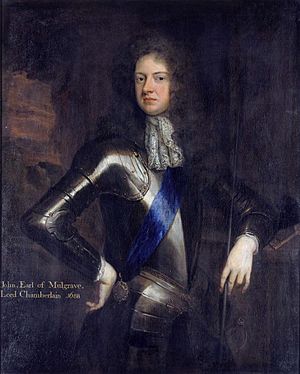John Sheffield, 1st Duke of Buckingham and Normanby facts for kids
Quick facts for kids
The Duke of Buckingham and Normanby
|
|
|---|---|

Portrait by Godfrey Kneller
|
|
| Lord President of the Council | |
| In office 13 June 1711 – 23 September 1714 |
|
| Monarch | Anne George I |
| Preceded by | The Earl of Rochester |
| Succeeded by | The Earl of Nottingham |
| In office 13 June 1711 – 1721 |
|
| 6th Duke of Buckingham | |
| Personal details | |
| Born | 8 September 1647 |
| Died | 24 February 1721 (aged 73) |
| Nationality | English |
| Occupation | poet, politician |
John Sheffield, 1st Duke of Buckingham and Normanby (born 7 April 1648, died 24 February 1721) was an important English poet and politician. He belonged to the Tory political party during the late Stuart period. He held high government positions like Lord Privy Seal and Lord President of the Council. Before becoming a Duke, he was known as Lord Mulgrave.
Contents
Early Life and Public Service
John Sheffield was the only son of Edmund Sheffield, 2nd Earl of Mulgrave. When his father passed away in 1658, John became the 3rd Earl of Mulgrave and 5th Baron Sheffield.
At just 18 years old, he joined the navy during the Second Anglo-Dutch War. This was a conflict between England and the Netherlands. In 1672, he fought in the Battle of Sole Bay. The next year, he was given command of his own ship.
He also became a colonel in the army. He served under a famous French general named Turenne. In 1674, he was honored with the title of Knight of the Garter. This is a very old and important award in England.
In 1680, John Sheffield led a mission to help the English soldiers in Tangier. This town was under attack by Moulay Ismail ibn Sharif.
Political Career and Royal Connections
At the royal court, John Sheffield supported the Duke of York. He helped cause the downfall of the Duke of Monmouth, who was a rival.
In 1682, he was removed from the court. This happened because he showed interest in marrying Princess Anne. She was 17 at the time, and he was 35.
When King James II became king, John Sheffield returned to favor. He was given a seat on the Privy Council, which advises the monarch. He also became Lord Chamberlain, a high-ranking official in the royal household.
He supported King James II even when the king made unpopular decisions. He stayed with the king in London when he was trying to escape. He also protected the Spanish ambassador from an angry crowd.
However, he later accepted the "Glorious Revolution" of 1688. This event saw King James II replaced by William and Mary. In 1694, he was made Marquess of Normanby.
In 1696, he and other Tory nobles refused to sign an agreement. This agreement would have declared William as their "rightful and lawful king." Because of this, he was removed from the Privy Council.
When Queen Anne came to the throne, John Sheffield was one of her favorites. She appointed him Lord Privy Seal and Lord Lieutenant of the North Riding of Yorkshire. In 1703, he was given the highest title: Duke of Buckingham and Normanby.
Later Life and Legacy
Between 1705 and 1710, the Whigs were in power. During this time, Buckingham lost his position as Lord Privy Seal. But in 1710, he became Lord Steward. In 1711, he was made Lord President of the Council.
After Queen Anne died, he was not reappointed to any government roles. He passed away on 24 February 1721. His home in St. James's Park is now the site of Buckingham Palace.
His son, Edmund, became the 2nd Duke. However, Edmund died young in 1735 without marrying. This meant that the titles of Duke of Buckingham and Normanby ended.
Literary Works
John Sheffield was also a writer and poet. He wrote essays like An Account of the Revolution and poems such as the Essay on Poetry and the Essay on Satire.
The Essay on Satire made fun of many important people. It was sometimes thought to be written by John Dryden, another famous poet. Because of this, Dryden was once attacked by people who were upset by the poem.
Sheffield was a supporter of Dryden. He also helped and encouraged Alexander Pope, a very famous poet. Pope thought highly of Sheffield's Essay on Poetry.
Sheffield even changed Shakespeare's play Julius Caesar. He split it into two plays, Julius Caesar and Marcus Brutus. He added songs between the acts, some of which were written by Alexander Pope.
After his death, his works were published. Some parts, like An Account of the Revolution, were removed from early authorized editions. This was because they were thought to support the Jacobites, who wanted to restore the old royal family.
Family Life
John Sheffield was married three times. His first wife was Ursula Stawell, whom he married in 1685. She passed away in 1697.
His second wife was Catherine Greville. They married in 1698, but she also died young in 1703.
His third wife was Lady Catherine Darnley. She was a daughter of King James II and Catherine Sedley. They married in 1705. They had three sons, but only one, Edmund, survived. Edmund later became the 2nd Duke.
John Sheffield also had a son named Charles with Frances Stewart. This son, Charles, inherited the family's estates after the 2nd Duke died. Charles became the first of the Sheffield baronets.

